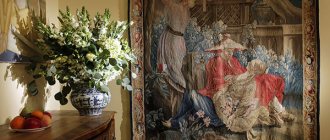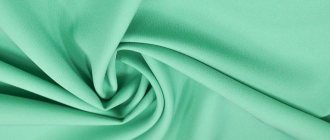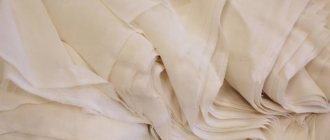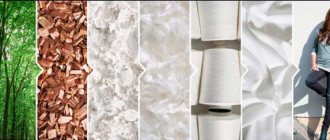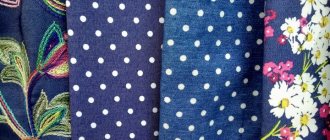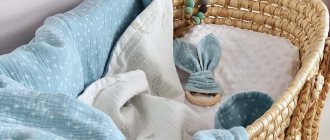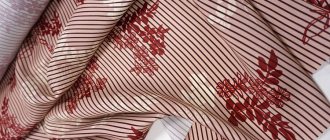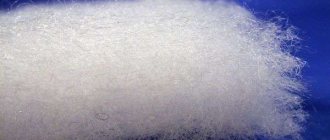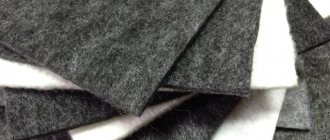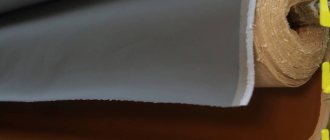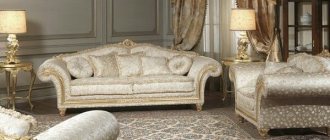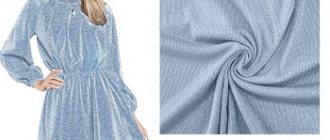Blended fabrics are made from natural and synthetic fibers that differ in composition and manufacturing method. This technology makes it possible to advantageously combine the best characteristics of various materials and create effective and durable combinations of fibers.
The main feature of mixed fabrics is versatility. Many different uniforms, outer and casual clothing, and decorative items are sewn from this material. The combination of dissimilar fibers allows you to create incredibly practical and durable things. What is a mixed fabric and what is it used for? We will tell you in the article.
Main production methods
The appearance, quality characteristics, and performance properties of the resulting material depend on the types of thread and spinning, and the method of mixing fibers. Currently, two types are used: monofilament and thread made by twisting fibers. In the first case, the fabric is externally aesthetic, but has crumbling ends. When using twisted varieties, the final fabric is durable and resistant to shedding, but acquires an uneven surface.
The quality and design are also influenced by production features:
- Mixing different fibers at the output produces a homogeneous fabric. Impregnations, moisture- and fire-resistant coatings can be applied to it. The back and front sides look similar.
- Mixing dissimilar threads ensures the production of double-sided material: the front surface is synthetic, the back surface is natural. The method is used when the external attractiveness of the material is important. Such species cannot be impregnated.
Important: The gloss or matt finish of the mixed product depends on the type of spinning. Rough and durable materials are produced using rotor spinning, while glossy, shiny varieties can be obtained using ring spinning.
Types and characteristics
Mixed fabrics are presented in a wide variety on the specialized market. The basis for differentiation is the percentage of natural and artificial components.
| Name | Compound | Characteristics |
| Greta | Cotton and polyester in a ratio of 35:65. The natural material is located on the inside, which provides tactile comfort. |
|
| Sisu | 23% cotton fiber, 77% polyester. Impregnated with water-repellent compounds. Produced in Belarus. |
|
| Tisi | 35% cotton. |
|
| Satori | High content of cotton fibers – over 50%. The homeland of the fabric is Japan. |
|
| Teredo | 67% polyester, 33% cotton. Made in Great Britain. |
|
| Polycotton | Cotton to polyester ratios can vary from 15:85 to 60:40. This affects density and other characteristics. |
With a high synthetic content, polycotton has poor air permeability, low hygroscopicity, and can cause skin irritation. |
| Orton | 50% polyamide fibers. They are located on the front side. Externally similar to twill. Has waterproof and oil-repellent impregnation. |
|
| Tomboy | 2/3 of the fabric is polyamide threads. |
|
| Memory | Natural fibers no more than 30%. Otherwise, the memory effect disappears. |
|
| NC | Tandem of nylon and cotton. Impregnated with moisture-resistant compounds. |
|
FYI: The final product may be marked "rip-stop". It means additional reinforcement with thin threads, which help maintain integrity during punctures or cuts. The aesthetic qualities of the fabric increase: they acquire an original texture.
Membranes
Membrane varieties can also be classified as canvases with a mixed composition. They have a multilayer structure. There are several modifications:
- A membrane is applied to a regular fabric from the inside out and protected with a lining.
- 3 layers (membrane, knitted mesh, fabric base) are connected by lamination.
- Three-layer material, but instead of mesh, foam jersey is used. Significantly reduces the weight of finished products.
The membrane material reliably protects from precipitation and wind, but at the same time allows evaporation to pass through, allowing the body to breathe and preventing the occurrence of sweat.
Blends that are popular
Some types of mixed fabrics are in particular demand among consumers.
| Name | Compound | Peculiarities |
| Tisi | Cotton 35%, polyester 65% | Well ventilated, does not wrinkle, dense, wear-resistant material. |
| Memory | Cotton 30%, polyester 65% | With memory effect. |
| Greta | Cotton 35%, polyester 65% | Cotton remains on the back side, synthetics on the front side. |
| Polycotton | Cotton from 15% to 65%, synthetics - from 35% to 85%. | Low creasing, no shrinkage, easy care. |
| Sisu | Cotton 13%, polyester 77%. | With blood-repellent impregnation, for sewing medical uniforms and workwear. |
| Teredo | Polyester 67%, cotton 33% | Lightweight, soft material, holds its shape well. |
Let's talk about shades
The color palette has no restrictions. You can find a wide variety of shades. Pure white tones predominate in the workwear of health workers, cooks, and confectioners. Dark ones are preferred by representatives of repair services. Camouflage is widely used. It can be found among hunting suits and fishing equipment. The material lends itself well to dyeing, and the addition of artificial fibers ensures brightness and richness of colors, and their ability to maintain their original appearance for a long time. Prints, floral and geometric patterns are applied to fabric surfaces.
Ironing
Before ironing, be sure to check the material for stains; if you iron them out, they can settle firmly in the fibers and subsequently cannot be removed. Ironing items while slightly damp will help prevent creases and creases. If the fabric is still dry, spray the material with water during ironing or use a similar function on the iron.
For better smoothing, use the steam function, if available.
For large items such as duvet covers, sheets, curtains or tablecloths, first fold them several times and iron first on one side, then on the other, and so on. Repeat the manipulations until the product is completely ironed.
Properties
In this case, we can talk about properties only in general terms. Any individual fabric has its own individual characteristics. But all mixed materials are characterized by:
- Durability. Artificial materials have been developed to increase the durability of canvases. Therefore, their presence in the composition ensures resistance to mechanical damage.
- Density. Depends on the weave of the threads. If they are located freely, the canvas will be airy and light. With close adhesion of even thin threads to each other, the density increases.
- Security. Mixed products do not emit toxins and are hypoallergenic.
Note: Each material imparts its own properties to the mixed composition. Polyester makes the final product crease-resistant. Adding nylon will result in a fabric with an elegant shine. The inclusion of elastane will give the fabric softness, flexibility, and it will drape easily.
The advantages of combining cotton and viscose in one fabric
The combination of components may be different. The most common option: when 50% cotton and 50% viscose. With other ratios, the mixture is still characterized by increased strength, but wet things made from it are easily damaged and shrink.
Cotton with viscose is a material that:
- does not spark, as it does not accumulate electrical charges;
- resistant against rotting bacteria, insects, mold fungi;
- non-toxic, environmentally friendly;
- lighter than its cotton counterpart;
- does not contain synthetics, so fabric items can be sewn even for infants;
- The color of the canvas remains bright for a long time.
Advantages
Materials with a mixed composition have become in demand among consumers due to their many advantages. They:
- Characterized by durability. The service life of some varieties reaches 5 years. For comparison, for cotton these indicators do not exceed 1-1.5 years.
- They have high performance properties: resistant to moisture, dust, and various temperatures.
- Provide comfort of use: they are hygroscopic, breathable, eliminating the development of pathogenic microflora.
- They are easy to care for: they don’t shed, don’t wrinkle, don’t shrink.
- Attracted by affordable price. The mixed material costs much less than natural material.
Please note: In pursuit of cheaper prices, some unscrupulous manufacturers add only a small percentage of natural fibers. This material has an aesthetic appearance and does not lose its shape for a long time, but its hygienic qualities leave much to be desired. Therefore, when purchasing, you should always study the label, which indicates the composition in percentage terms of components.
Flaws
With an optimal combination of natural and artificial components, mixed fabrics are practically free of disadvantages. When working with some materials, cutting difficulties may arise due to the special structure of the fibers. Defects are observed in cases where the composition contains a high percentage of synthetics. Such varieties become electrified and their hygroscopicity decreases. They can create a greenhouse effect and not maintain natural body temperature. At the same time, tactile characteristics also deteriorate: the material becomes hard to the touch, can rub the skin, and cause allergies.
Manufacturing technology
For mixed fabrics, natural and synthetic fibers are used.
Cotton fibers of plant origin are used as a natural base. Cotton is a lightweight material, soft and environmentally friendly, pleasant to the touch, but wrinkles and deforms a lot. The base is supplemented with synthetic fibers, which are made from polymers and inorganic compounds. There is usually more synthetics in the composition - 60-70%, while cotton is 30-40%.
Synthetics dry instantly and quickly absorb moisture. This material is durable, very strong and almost does not wrinkle. The result is a comfortable fabric that has the advantages of natural material and synthetics. Often mixed fabrics are impregnated with a protective composition against moisture, dirt and wind.
Application area
The universal material has firmly entered modern life. You can meet it in various fields. First of all, it is used to produce workwear for workers in various industries. Where exactly the uniform is used depends on the composition:
- Fabrics with a high cotton content were appreciated by workers in the gas industry and aviation.
- Options with a predominance of synthetic threads (especially polyester) have found their place among builders, metallurgists, and medical workers.
- The combined fabric, impregnated with fire-resistant compounds, has become indispensable for workers in energy production.
- A mixture with a water-repellent, wind- and dirt-resistant coating is used for sewing outerwear for representatives of the police, the Ministry of Emergency Situations, and traffic police, that is, those people who spend a lot of time on the street.
Also, the combination of artificial and natural threads allows us to produce comfortable, reliable equipment for athletes, tourists, fishermen, and hunters. Mixed fabrics are also used for sewing everyday clothes: jackets, raincoats, children's overalls, skirts, dresses.
This is interesting: Most mixed formulations are classified as medical types: teredo, satori, tishi, shisu. For employees of security and law enforcement agencies, Greta and membrane camouflage are most often used, for workers in the food industry - Orton. Memory is used to make outerwear and casual clothing, while NC is in demand in the production of shorts, skirts, and trousers.
In addition, universal fabrics are found in home textiles (pillows, bed linen, blankets). They are used as covers for furniture, in the production of accessories (umbrellas, bags), car and country awnings, in the form of fabric inserts in summer shoes, for the manufacture of tents, and climbing equipment.
What is sewn from mixed fabrics?
Any print can be applied to mixed fabrics.
The mixed material turns out to be incredibly functional and durable. The ease of coloring allows you to create any product design. Logos, embroidery, appliqués, and camouflage prints can be applied to mixed fabrics. The protective composition increases the strength of the material and makes it suitable for use in adverse weather conditions.
Blended fabric is used for sewing the following products:
- sports and travel clothing;
- overalls for fishing and hunting;
- outerwear (jackets);
- military uniform;
- signaling clothing;
- uniforms for industrial workers;
- uniforms for workers of medical institutions and service personnel in the field of recreation;
- casual clothes (blouses, skirts, trousers, suits, robes);
- car awnings;
- bags;
- umbrellas;
- shoes.
A huge range of applications indicates the versatility of mixed fabrics. The attractive price makes this material accessible to any family and increases the popularity of an active lifestyle and corporate dress code.
Rules of care
Products made from mixed threads do not require special care, but some rules must be followed:
- Washing in an automatic machine is possible at a temperature not exceeding +40 degrees. Minimum time – 10 minutes.
- Home dry cleaning is prohibited. This procedure should only be trusted to specialists. In special institutions, after dry cleaning, products are dried with a stream of hot air and ironed. The temperature is +160 degrees.
Be sure to read the information on the label, as care for different fabrics may differ.
Greta
Even heavy dirt can be easily removed with a napkin or a regular brush. Machine washable using liquid detergents that do not contain chlorine.
Sisu
Hand and machine washing methods are allowed. Dries quickly. The product does not need ironing.
Tisi
Wash only at low temperatures. If there is colored trim or inserts, do not use bleaches. Iron from the wrong side.
Satori
Solid varieties can be boiled. Autoclaving (treatment with hot steam at high pressure) is allowed. When combining light and dark shades, the temperature should not exceed +40 degrees. When ironing, the soleplate of the iron should not be higher than +150 degrees.
Teredo
Washing is allowed at temperatures up to +85 degrees. Hot water will not affect color, size, shape. For snow-white products, bleaching with products containing chlorine is allowed. Teredo is usually labeled easycare, which means “easy care.” This nano-finish prevents creases and eliminates the need to iron the material.
Polycotton
When washing, be sure to turn things inside out (especially pillowcases and duvet covers). Ironing is only possible under gentle heat conditions. Dry naturally, but in a shaded place. Linen should be protected from direct sunlight.
Orton
Products can be washed at minimum temperature. Dry cleaning using hydrocarbons is also permitted. Bleaching is strictly prohibited. Ironing is allowed, but the thermal regime should not exceed +150 degrees.
Tomboy
Can be washed at temperatures up to +85 degrees. It is better to avoid machine drying. Products should be dried flat. There is no need to iron them.
For reference: 50 dry cleaning cycles deteriorate the quality characteristics of a tomboy made in the UK by only 10%. For similar materials produced in Russia, this figure increases to 40%, and for analogues from China it is 90%.
Memory
Suitable for hand and machine wash in cool water. Do not use machine spinning as this will negatively affect the properties of the fabric. The use of stain removers, solvents, and chlorine-containing bleaches is prohibited. Ironing is possible at a temperature of +150 degrees.
NC
The fabric is easy to clean. Thanks to the moisture-resistant coating, it dries quickly. But you need to squeeze it manually, without twisting the product. It is advisable to use moisture-absorbing material. NC should be washed rarely, as frequent washing has a detrimental effect on the impregnation. The material loses its moisture-resistant properties. Iron only from the wrong side.
Where else are they used?
Mixed fabrics are used everywhere . In addition to the fact that they are used to make equipment for military personnel, workers in various fields and just people who love active recreation, the material has found application:
- tourist tents;
- shoes;
- covers for fishing rods;
- bags;
- climbing equipment;
- car awning;
- umbrella.
Different manufacturers have different options for completing the Gorka suit.
We will tell you what types of Gorka costumes there are in a special review. Find out what standards and requirements apply to the production of winter maskhalat here.
